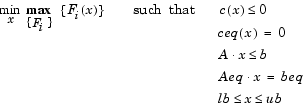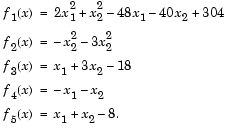

| Optimization Toolbox |   |

where x, b, beq, lb, and ub are vectors, A and Aeq are matrices, c(x), ceq(x), and F(x) are functions that return vectors. F(x), c(x), and ceq(x) can be nonlinear functions.
Syntax
x = fminimax(fun,x0) x = fminimax(fun,x0,A,b) x = fminimax(fun,x0,A,b,Aeq,beq) x = fminimax(fun,x0,A,b,Aeq,beq,lb,ub) x = fminimax(fun,x0,A,b,Aeq,beq,lb,ub,nonlcon) x = fminimax(fun,x0,A,b,Aeq,beq,lb,ub,nonlcon,options) x = fminimax(fun,x0,A,b,Aeq,beq,lb,ub,nonlcon,options,P1,P2,...) [x,fval] = fminimax(...) [x,fval,maxfval] = fminimax(...) [x,fval,maxfval,exitflag] = fminimax(...) [x,fval,maxfval,exitflag,output] = fminimax(...) [x,fval,maxfval,exitflag,output,lambda] = fminimax(...)
Description
fminimax minimizes the worst-case value of a set of multivariable functions, starting at an initial estimate. The values may be subject to constraints. This is generally referred to as the minimax problem.
x = fminimax(fun,x0)
starts at x0 and finds a minimax solution x to the functions described in fun.
x = fminimax(fun,x0,A,b)
solves the minimax problem subject to the linear inequalities A*x <= b.
x = fminimax(fun,x,A,b,Aeq,beq)
solves the minimax problem subject to the linear equalities Aeq*x = beq as well. Set A=[] and b=[] if no inequalities exist.
x = fminimax(fun,x,A,b,Aeq,beq,lb,ub)
defines a set of lower and upper bounds on the design variables, x, so that the solution is always in the range lb <= x <= ub.
x = fminimax(fun,x0,A,b,Aeq,beq,lb,ub,nonlcon)
subjects the minimax problem to the nonlinear inequalities c(x) or equality constraints ceq(x) defined in nonlcon. fminimax optimizes such that c(x) <= 0 and ceq(x) = 0. Set lb=[] and/or ub=[] if no bounds exist.
x = fminimax(fun,x0,A,b,Aeq,beq,lb,ub,nonlcon,options)
minimizes with the optimization parameters specified in the structure options. Use optimset to set these parameters.
x = fminimax(fun,x0,A,b,Aeq,beq,lb,ub,nonlcon,options,P1,P2,...)
passes the problem-dependent parameters P1, P2, etc., directly to the functions fun and nonlcon. Pass empty matrices as placeholders for A, b, Aeq, beq, lb, ub, nonlcon, and options if these arguments are not needed.
[x,fval] = fminimax(...)
returns the value of the objective function fun at the solution x.
[x,fval,maxfval] = fminimax(...)
returns the maximum function value at the solution x.
[x,fval,maxfval,exitflag] = fminimax(...)
returns a value exitflag that describes the exit condition of fminimax.
[x,fval,maxfval,exitflag,output] = fminimax(...)
returns a structure output with information about the optimization.
[x,fval,maxfval,exitflag,output,lambda] = fminimax(...)
returns a structure lambda whose fields contain the Lagrange multipliers at the solution x.
Input Arguments
Function Arguments contains general descriptions of arguments passed in to fminimax. This section provides function-specific details for fun, nonlcon, and options:
fun |
The function to be minimized. fun is a function that accepts a vector x and returns a vector F, the objective functions evaluated at x. The function fun can be specified as a function handle.where myfun is a MATLAB function such asfun can also be an inline object.To minimize the worst case absolute values of any of the elements of the vector F(x) (i.e., min{max abs{F(x)} } ), partition those objectives into the first elements of F and use optimset to set the MinAbsMax parameter to be the number of such objectives. If the gradient of the objective function can also be computed and the GradObj parameter is 'on', as set bythen the function fun must return, in the second output argument, the gradient value G, a matrix, at x. Note that by checking the value of nargout the function can avoid computing G when myfun is called with only one output argument (in the case where the optimization algorithm only needs the value of F but not G). |
The gradient consists of the partial derivative dF/dx of each F at the point x. If F is a vector of length m and x has length n, where n is the length of x0, then the gradient G of F(x) is an n-by-m matrix where G(i,j) is the partial derivative of F(j) with respect to x(i) (i.e., the jth column of G is the gradient of the jth objective function F(j)). |
|
nonlcon |
The function that computes the nonlinear inequality constraints c(x) <= 0 and nonlinear equality constraints ceq(x) = 0. The function nonlcon accepts a vector x and returns two vectors c and ceq. The vector c contains the nonlinear inequalities evaluated at x, and ceq contains the nonlinear equalities evaluated at x. The function nonlcon can be specified as a function handle.where mycon is a MATLAB function such as
GradConstr parameter is 'on', as set bythen the function nonlcon must also return, in the third and fourth output arguments, GC, the gradient of c(x), and GCeq, the gradient of ceq(x). Note that by checking the value of nargout the function can avoid computing GC and GCeq when nonlcon is called with only two output arguments (in the case where the optimization algorithm only needs the values of c and ceq but not GC and GCeq). |
If nonlcon returns a vector c of m components and x has length n, where n is the length of x0, then the gradient GC of c(x) is an n-by-m matrix, where GC(i,j) is the partial derivative of c(j) with respect to x(i) (i.e., the jth column of GC is the gradient of the jth inequality constraint c(j)). Likewise, if ceq has p components, the gradient GCeq of ceq(x) is an n-by-p matrix, where GCeq(i,j) is the partial derivative of ceq(j) with respect to x(i) (i.e., the jth column of GCeq is the gradient of the jth equality constraint ceq(j)). |
|
options |
Options provides the function-specific details for the options parameters. |
Output Arguments
Function Arguments contains general descriptions of arguments returned by fminimax. This section provides function-specific details for exitflag, lambda, maxfval, and output:
Options
Optimization options parameters used by fminimax. You can use optimset to set or change the values of these fields in the parameters structure, options. See Optimization Parameters, for detailed information:
DerivativeCheck |
Compare user-supplied derivatives (gradients of the objective or constraints) to finite-differencing derivatives. |
Diagnostics |
Print diagnostic information about the function to be minimized or solved. |
DiffMaxChange |
Maximum change in variables for finite-difference gradients. |
DiffMinChange |
Minimum change in variables for finite-difference gradients. |
Display |
Level of display. 'off' displays no output; 'iter' displays output at each iteration; 'final' (default) displays just the final output. |
GradConstr |
Gradient for the constraints defined by user. See the description of nonlcon above to see how to define the gradient in nonlcon. |
GradObj |
Gradient for the objective function defined by user. See the description of fun above to see how to define the gradient in fun. The gradient must be provided to use the large-scale method. It is optional for the medium-scale method. |
MaxFunEvals |
Maximum number of function evaluations allowed. |
MaxIter |
Maximum number of iterations allowed. |
MeritFunction |
Use goal attainment/minimax merit function if set to 'multiobj'. Use fmincon merit function if set to 'singleobj'. |
MinAbsMax |
Number of F(x) to minimize the worst case absolute values. |
TolCon |
Termination tolerance on the constraint violation. |
TolFun |
Termination tolerance on the function value. |
TolX |
Termination tolerance on x. |
Examples
Find values of x that minimize the maximum value of


First, write an M-file that computes the five functions at x.
function f = myfun(x) f(1)= 2*x(1)^2+x(2)^2-48*x(1)-40*x(2)+304; % Objectives f(2)= -x(1)^2 - 3*x(2)^2; f(3)= x(1) + 3*x(2) -18; f(4)= -x(1)- x(2); f(5)= x(1) + x(2) - 8;
Next, invoke an optimization routine.
After seven iterations, the solution is
Notes
The number of objectives for which the worst case absolute values of F are minimized is set in the MinAbsMax parameter using optimset. Such objectives should be partitioned into the first elements of F.
For example, consider the above problem, which requires finding values of x that minimize the maximum absolute value of

This is solved by invoking fminimax with the commands
x0 = [0.1; 0.1]; % Make a starting guess at the solution options = optimset('MinAbsMax',5); % Minimize absolute values [x,fval] = fminimax(@myfun,x0,[],[],[],[],[],[],[],options);
After seven iterations, the solution is
If equality constraints are present and dependent equalities are detected and removed in the quadratic subproblem, 'dependent' is printed under the Procedures heading (when the Display parameter is set to 'iter'). The dependent equalities are only removed when the equalities are consistent. If the system of equalities is not consistent, the subproblem is infeasible and 'infeasible' is printed under the Procedures heading.
Algorithm
fminimax uses a Sequential Quadratic Programming (SQP) method [1]. Modifications are made to the line search and Hessian. In the line search an exact merit function (see [2] and [4]) is used together with the merit function proposed by [3] and [5]. The line search is terminated when either merit function shows improvement. A modified Hessian that takes advantage of special structure of this problem is also used. Using optimset to set the MeritFunction parameter to'singleobj' uses the merit function and Hessian used in fmincon.
See also SQP Implementation for more details on the algorithm used and the types of procedures printed under the Procedures heading when the Display parameter is set to'iter'.
Limitations
The function to be minimized must be continuous. fminimax may only give local solutions.
See Also
@ (function_handle), fgoalattain, lsqnonlin, optimset
References
[1] Brayton, R.K., S.W. Director, G.D. Hachtel, and L.Vidigal, "A New Algorithm for Statistical Circuit Design Based on Quasi-Newton Methods and Function Splitting," IEEE Trans. Circuits and Systems, Vol. CAS-26, pp. 784-794, Sept. 1979.
[2] Grace, A.C.W., "Computer-Aided Control System Design Using Optimization Techniques," Ph.D. Thesis, University of Wales, Bangor, Gwynedd, UK, 1989.
[3] Han, S.P., "A Globally Convergent Method For Nonlinear Programming," Journal of Optimization Theory and Applications, Vol. 22, p. 297, 1977.
[4] Madsen, K. and H. Schjaer-Jacobsen, "Algorithms for Worst Case Tolerance Optimization," IEEE Transactions of Circuits and Systems, Vol. CAS-26, Sept. 1979.
[5] Powell, M.J.D., "A Fast Algorithm for Nonlineary Constrained Optimization Calculations," Numerical Analysis, ed. G.A. Watson, Lecture Notes in Mathematics, Springer Verlag, Vol. 630, 1978.
 | fmincon | fminsearch |  |